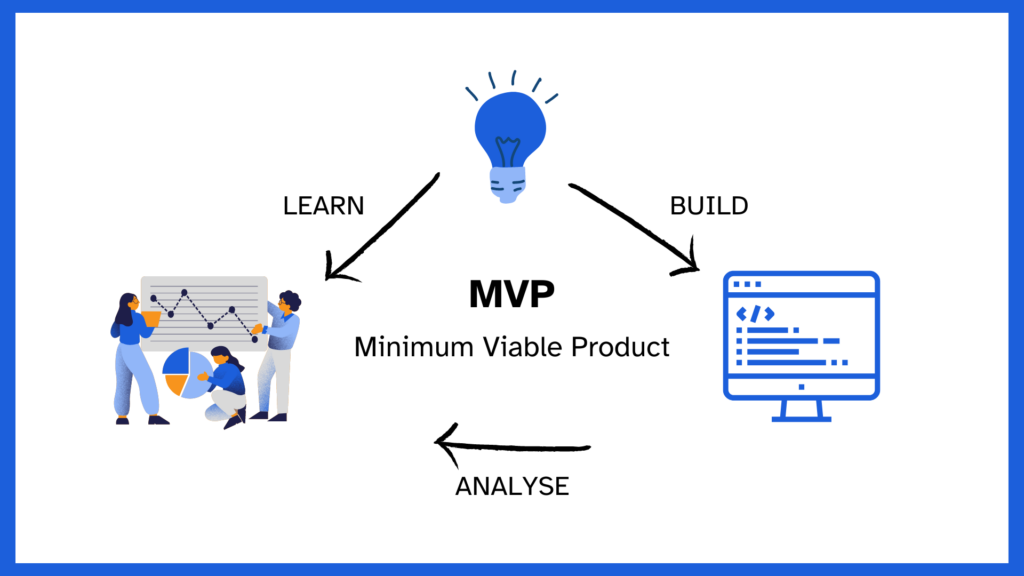Minimum Viable Product vs Prototype: Choosing the Right Early Version for Your App

In today’s rapidly evolving and competitive app market, launching a full-fledged product without proper validation can be a costly and time-consuming mistake. The lean startup methodology emphasizes an agile approach to mitigate such risks, advocating for the use of prototypes and Minimum Viable Products (MVPs) as initial representations of your app vision.
While both prototypes and MVPs serve the common purpose of testing and refining your app ideas before committing significant resources to full development, they are distinct tools serving different stages of the development process. Understanding these key differences will equip you with the knowledge to make informed decisions about which approach is most suitable for your specific needs and maximize your chances of success in the dynamic app landscape.
What is a Prototype?
Think of a prototype as a rough sketch of your app’s vision. It serves as a non-functional model used to test the concept and user experience (UX) before development begins. Imagine buttons, layouts, animations, and the overall user interface coming to life through various mediums like napkin sketches, simple mockups, or even detailed documentation outlining the product’s underlying idea.

Prototypes are particularly beneficial in the planning stage, offering valuable insights into the following:
- Design and UX: Prototypes allow you to visualize how users will navigate the interface, interact with features, and experience the overall flow of your app, enabling you to identify potential usability issues and refine the design for an optimal user experience.
- Low Functionality: Unlike MVPs, prototypes often lack real functionality or only provide basic features. Their primary purpose is not to allow users to complete tasks within the app, but rather to gather feedback on the design and user experience before investing heavily in development efforts.
- Quick and Easy to Create: Due to their low-fidelity nature, prototypes can be created quickly and easily using various online tools and software, making them ideal for early-stage exploration and iteration.
Example: Imagine you have a brilliant idea for a food delivery app. However, you’re unsure what features users would find most valuable and how they would navigate the app to place their orders. To address these uncertainties, you decide to create a prototype. This prototype could be a simple paper mockup or a basic digital version with just the main screens, such as the home screen, restaurant selection screen, and order confirmation page. While it wouldn’t have the full functionality of the final app, it would allow you to:
- Test the basic flow of the app, from browsing restaurants to placing an order.
- Get feedback from potential users on the design and usability of the interface.
- Gain valuable insights into whether your app idea resonates with users and addresses their needs.
Based on the feedback you receive from testing your prototype, you can then make informed decisions about whether to continue developing the app and what features to prioritize based on user needs and preferences.
What is the Minimum Viable Product for Web App?
The Minimum Viable Product (MVP) takes a different approach compared to prototypes. It represents a fully functional, bare-bones version of your app, incorporating just enough features to address the core problem you’re trying to solve and provide immediate value to your users.

Here are the key characteristics of an MVP:
- Focus on Core Functionality: MVPs prioritize the essential features that solve the core problem your app is designed to address. They are intentionally designed to be simple and usable, avoiding unnecessary complexity or features that detract from the core user experience.
- Minimum Development Time: As the name suggests, MVPs are developed to minimize development time and resources. This allows you to launch your app quickly and gather valuable user feedback to inform further development efforts.
- Real-World Testing: Unlike prototypes, MVPs are not confined to the drawing board or limited testing environments. They are released to a limited audience, often through beta testing programs, to gather real-world data on user interaction and app effectiveness in a real-world context.
Example: Let’s assume you’ve conducted thorough market research and feel confident that your food delivery app idea has substantial potential. You have a clear understanding of the core features users need and are eager to test your app with real users in a real-world setting. This is where an MVP comes into play.
Your MVP would be a fully functional version of the app but with only the most critical features. These features might include:
- Browsing restaurants and menus.
- Placing and tracking orders.
- Secure payment processing.
- Real-time order updates.
Your MVP would allow you to:
- Launch the app to a limited audience of early adopters or beta testers.
- Collect and analyze real-world data on how users interact with the app.
- Identify usability issues and areas for improvement.
Choosing the Right Approach: Prototype vs Minimum Viable Product
The choice between a prototype and an MVP depends on your specific needs and stage of development. Here’s a quick guide to help you decide:
Choose a Prototype if:
- You need to figure out your app’s concept and need to validate the overall idea.
- You want to test the design and user experience before investing significant resources in development.
- You’re in the early stages of planning and need a quick and inexpensive way to visualize your app.
Choose an MVP if:
- You have a clear idea of your app’s core functionality and value proposition.
- You need to gather user feedback on the actual usability and effectiveness of your app.
- You’re ready to launch your app to a limited audience and iterate based on real-world data.
MVP vs Prototype which serves the purpose right?
Both MVP and Prototype are vital for the success of a product. They serve different important purposes at various stages of the development process. If you want to test raw product concepts with minimal financial investment, then it’s best to choose a prototype. On the other hand, if you wish to measure feature performance against genuine user needs and gauge user preference, then an MVP would be a better option. In short, MVP (Minimum Viable Product) is a basic version to test the idea and a Prototype is a preliminary model for design validation.
Partnering for Success
Developing a successful digital product requires expertise and guidance, and partnering with MVP development services can significantly enhance your journey. By collaborating with experienced professionals, you gain valuable insights into the intricacies of product development, specifically of building a Minimum Viable Product (MVP).
This partnership not only deepens your understanding of the MVP development process but also empowers you to adopt a more strategic and effective approach. From crafting a tailored MVP to navigating the different stages of development, your service provider ensures informed decisions and optimal solutions every step of the way. This collaboration paves the way for a successful product launch that exceeds user expectations.
Conclusion
Ultimately, the best approach is to leverage both prototypes and MVPs strategically. By understanding their nuances and applying the golden rules of customer focus, data-driven decisions, adaptability, and action, you’ll be well-equipped to navigate the product development journey and achieve success.
Actionable Notes:
- Don’t be afraid to pivot: Regardless of whether you choose a prototype or an MVP, be willing to adapt and change your approach based on user feedback.
- Focus on user needs: Always prioritize solving user problems and providing value above all else.
- Test, iterate, and learn: The key to success lies in continuous testing
- Consider collaborating with experienced MVP development services providers like HCode to access specialized expertise and streamline your MVP development process.
